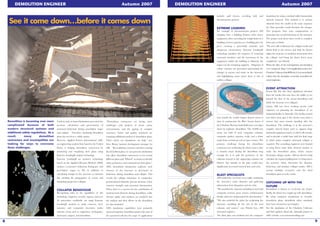
Demolition Analysis Article
- 1. DEMOLITION ENGINEER Autumn 2007 8 DEMOLITION ENGINEER Autumn 2007 9 Demolition is becoming ever more complicated because of both modern structural systems and additional safety regulations. As a result, many demolition contractors and municipalities are looking for ways to overcome these challenges. Until recently technical limitations prevented the accurate calculation and presentation of structural behaviour during post-failure stages and collapse. Therefore, simulating demolition plans has not been a viable option. However, Applied Science International (ASI), an engineering analysis firm based in the United States, is helping demolition contractors by simulating and visualising their plans using Extreme Loading® analysis technology. Extreme Loading® an exclusive technology based on the Applied Element Method (AEM) analyses a structure’s behaviour during pre- and post-failure stages in 3D, in addition to calculating changes in the structure as elements fail, tracking the propagation of cracks, and simulating progressive collapse. COLLAPSE BEHAVIOUR Recognising value in the capabilities of this technology engineers, security experts, and over 50 universities worldwide are using Extreme Loading® analysis to study concrete, steel, masonry and composite structures under extreme events such as explosions, earthquakes, hurricanes, impact, and demolition. “Demolition contractors are facing more challenges with projects in dense urban environments, and the ageing of complex structures. Safety and quality standards are requiring additional analysis of demolition plans. That’s where our simulations can help,” says Steve Bruns, business development manager for ASI. “By modeling a structure and then running the demolition plan, we can generate simulations that allow demolition contractors to test several different plans and ‘What-if’ scenarios to identify safety perimeters, and communicate their plans.” ASI’s demolition simulations replicate each element of the structure to determine its behaviour during demolition and collapse. This reveals the collapse behaviour of composites, post-tensioned elements, precast elements, rebar, concrete strength, and structural deterioration. When there is a concern for the contribution of nonstructural elements during demolition, walls, elevator shafts, and windows are modeled into the analysis and their effects on the demolition are also simulated. ASI’s simulation capabilities have primarily attracted explosive demolition projects because of the associated risk but the scope of applications include: pull downs, wrecking ball, and deconstruction projects. EXTREME LOADING For example in deconstruction projects ASI simulates how a building behaves when heavy equipment, often exceeding the weight limits of a building, removes portions of a building piece by piece creating a potentially unstable and dangerous environment. Extreme Loading® technology simulates the sequence of removing structural members and the movement of the equipment within the building to illustrate the impact on the remaining supports. Diagrams of colour contours are generated representing the changes in stresses and strain on the structure, and highlighting zones where there is risk of sudden collapse. Last month the world‘s largest domed arena at time of construction ‘the Hive’ former home of the Charlotte Hornets basketball team was taken down by explosive demolition. The 24,000 seat arena was built of steel, composite columns, composite girders, masonry walls, and a dome made from an intricate web of space trusses. The primary challenge facing the demolition contractor was weakening the dome truss so that it remains intact during the demolition long enough for it to pull the perimeter of the coliseum inward as the supporting columns are blasted. Any mistake in the plan would have significantly increased removal time and costs. BLAST SPECIALISTS ASI studied the case from every angle, examining the structure’s main elements and gathering information from blueprints and site visits. “We modeled the coliseum including its steel and composite sections, space trusses, reinforcement details, and even compensated for deterioration.” “We also modeled the plans for weakening the structure, modeling all the cuts in the steel columns and trusses,” says Patrick Lea, ASI structural engineer. The blast plan was modeled into the computer simulation by using a method called immaculate element removal. This method is to remove elements from the model in the same sequence the blast specialist would detonate the charges. The program then runs computations to determine the overall behaviour of the structure. The project took about three weeks to complete from start to finish. “We were able to illustrate the collapse mode and debris field to the owners and help the blaster adjust the sequence to maintain momentum thru the collapse and bring the dome down more completely,” says Patrick. When the video of the real implosion and simulation were compared, (http://www.appliedscienceint.com/ Charlotte Coliseum.shtml#Movie) it was immediately evident that the simulation accurately resembled the actual implosion. EVENT ATTRACTION Events like this also draw significant attention from the media who now have the ability to see beyond the dust of the actual demolition and inside the structure as it collapses. Lately, ASI has been working closely with engineers on planning the demolition of an industrial facility in Australia. The facility, retired over three years ago, is five meters away from a reactor that must remain standing after the demolition. The challenge is in the structure’s complex braced frame used to support large industrial equipment much of which will remain, and to provide a stable base until the final stage at which point complete structural collapse is required. The consulting engineers were limited to using linear static finite element analysis to study the demolition plans, which cannot determine collapse modes. ASI was hired to help calculate the required pulling force to bring down the structure safely, determine the dynamic behaviour, and simulate collapse modes. ASI is testing multiple scenarios and the final demolition plan is in the works. CATCHING UP WITH THE FUTURE Demolition is known to accelerate the future; finally, the future has caught up with demolition. By using computer simulations to visualise demolition plans, demolition safety standards have been elevated to new heights. See the simulation of the Charlotte Coliseum and find updates about the Australia project at ASI’s website: www.extremeloading.com. See it come down…before it comes down
